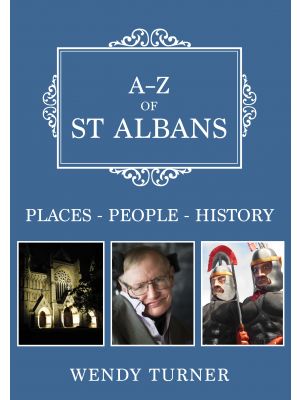


Quote from Three Men in a Boat, Jerome K. Jerome, 1889: The first thing they would see in Kent, when they got there, would be Henry and Anne fooling round Hever Castle. ‘Oh, drat this!’ they would have said. ‘Here, let’s go away. I can’t stand any more of it. Let’s go to St Albans – nice quiet place, St Albans.’ And when they reached St Albans, there would be that wretched couple, kissing under the Abbey walls.
Henry and Anne are said to have courted under the magnificent cedar tree in St Stephen’s church carpark. It’s also rumoured that the King Harry public house nearby is named for him. Henry and Anne are but some of the many faces of St Albans. King Offa of Mercia is credited with building a monastery to Alban in AD793. The twelfth-century Sopwell Priory had an adventurous abbess, Dame Juliana Berners, who championed the benefits of the outdoor life. Her book on fishing was one of the first to be printed in English.
History tells of the Romans in Roman Verulamium, still much unexcavated, and Alban, the first British Christian martyr who swapped cloaks with a fugitive priest and suffered beheading for his trouble. His story is re-enacted annually on Alban Day in June when thousands of people line the main road to watch the larger-than-life puppets parading their way to St Albans cathedral where a mock beheading takes place.
Yet there is a darker side to the city. St Albans Registry Office was once a prison where executions were carried out and where murderers and poisoners lurked. The gates and frontage of the building appeared in the BBC TV’s series Porridge with Ronnie Barker.
The seventeenth-century traveller Fynes Moryson found St Albans to be ‘a pleasant towne, full of faire innes’. It is still that and much more. This book takes you on an alphabetical tour of the city now and then, retelling the stories of notable places, people and their histories.
Hot Cross Buns
In 1361 Brother Thomas Rocliffe, a monk at St Alban’s Abbey, put together a recipe for making small sweet spiced cakes for the poor on Good Friday of that year. His original recipe remains secret but it is known to include flour, eggs, yeast, currants and grains of cardamom or paradise. The buns have crosses on top cut with a knife rather than being piped. The Alban Bun is believed to be the forerunner of the Hot Cross Bun. They are a firm part of the abbey’s Easter tradition and are available in the Abbot’s Kitchen during March and April each year. The famous bun made an appearance on Mary Berry’s Easter Feast in Lent, 2016.
You can buy the book from the publisher, Amberley Books, or from Amazon, or use the QR codes below.

